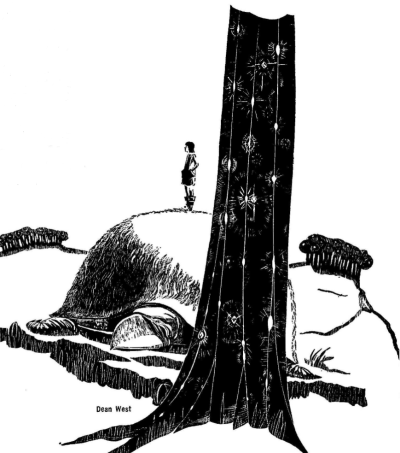Brian
This is a funny choice for the first in our series of Nebula winners/nominees, because it’s not what you’d think of as a Nebula-type story and Schmitz is not a Nebula-type writer. He’s not a Delany or Wilhelm or Tiptree, but from the previous literary generation — indeed from a different tradition within genre SF. Rather than try to give us complex characters or marry SF conventions to a literary bent, he’s happy to give us some good ideas, some imaginatively conceived aliens, and characters who are, while not deeply drawn, likable enough. “Balanced Ecology” both is and is not a typical Analog story, or rather it’s a typical Analog story done well and without the worst downsides often seen in the form. It’s a human drama essentially about deforestation and the need to preserve environmental balance, but with a conclusion that would not be possible if said environment didn’t host intelligent alien life. We’re introduced to a planet, Wrake, and a highly valued SFnal resource with diamondwood. Our heroes, Ilf and his cousin Auris, are children who are raised under the same roof, but it turns out a tricky legal situation may jeopardize what ought to be their inheritance of the diamondwood farm.
The story’s environmentalism is scientifically rather than philosophically argued, although that doesn’t stop an anti-capitalist aura from creeping in on a subtextual level — because the need of capital for endless resource-hoarding runs at odds with the health of the natural world. On top of this, the racism and sexism that would sometimes pop in SF of this vintage are totally absent. Schmitz is often praised for writing female characters who are intelligent, free-thinking, courageous, and not constantly condescended to; and Auris continues this streak. This is not a story you have to recommend with an asterisk slapped on the end saying, “Well it was written under different circumstances than what we would now deem acceptable.” The reality of course is that this is always true of fiction, no matter the genre or when it was written, that the author was working off of different expectations than what we now have, but “Balanced Ecology” does not show its age, really. It’s not a masterpiece, but it does have a quality of timelessness such that it could probably be published in Analog today without major revisions. That’s not praise that can be often thrown at old SFF stories — even the certified classics.
Kris
Schmitz is one of those writers who I generally don’t think much about. Much of his work seems to fall into solid, inoffensive, but forgettable Campbellian fiction. This, however, is a notable exception.
Even though there is a lot of science in here, it is not what I would expect from an Analog story, Rather it feels like something you might get from Bradbury, Simak or Zelazny in its beautiful prose about rural life. In fact, the first couple of paragraphs almost lulls you in to thinking this is not actually an SF story. Yes, the trees are diamondwood which I don’t believe is a real type but no reason one could not be called that. It is only when the tumbleweeds start drinking and making noises we are definitely in speculative territory.
Schmitz manages a delicate balancing act of keeping between being a middle-grade fable and a scientific treatise. Instead, we are kept in this in between place with a grounded sense of wonder throughout.
It is notable that the cover of the magazine is the famous Schoenherr cover for Dune. Two and a half years after The Silent Spring, we can definitely see how growing environmental concern is influencing science fiction.

